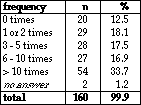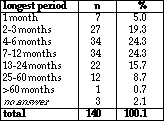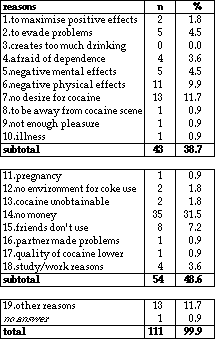Cohen, Peter (1989),
Cocaine use in Amsterdam in non-deviant subcultures. In: Peter Cohen (1990),
Drugs as a social construct. Dissertation. Amsterdam, Universiteit
van Amsterdam. pp. 101-105.
© Copyright 1990 Peter Cohen.
All rights reserved.
4. Abstinence from cocaine use
Peter Cohen
Table of contents
4.1 Introduction
Are people who start to use cocaine able to stop, or does one line inevitably lead to another, in ever increasing doses and without pause? In Chapter 3 our information led us to the conclusion that a use pattern characterized by ever increasing dose is a rarity when we look at careers of longer than 5 years. But, if we found a low prevalence of periods of abstinence, this could still offer some support to the classic view, e.g. Täschner's "that cocaine users develop dependence after a short period (of use)" (Täschner, 1987, 376; Täschner and Richtberg, 1982).
4.2 Periods of abstinence
A very large proportion of the users reported to have stopped for more than a month (86.2% against 12.5% who never did this) since the start of their cocaine use, see Table 4.2.a.
Table 4.2.a Number of times people stopped using cocaine 1 month or longer

There is a minor correlation between the number of times people stop using cocaine and their level of use during the period of maximum use. Low users have an average of 7.5 abstinences of 1 month or longer, medium users of 5.2 times and high users of 6.8 times (Pearson's r=-0.16, p=0.03). Medium users stop less often than all the others. The respondents that stopped one or more times are different in certain respects when compared with those who never stopped. See Table 4.2.b.
Among those who never stopped using during their cocaine career we see relatively more high level users in the period of heaviest use (top period). Compared with those who stopped more than 10 times, this difference is significant (chi2, a = 0.05).
Second, among those who never interrupted their use of cocaine, fewer did not use any cocaine in the three months preceding the interview. In comparison to those who 'ever' stopped their use, however, this is not statistically significant.
Table 4.2.b Comparison of respondents who never stopped using cocaine for more than 1 month with respondents who ever stopped and with those who stopped more than 10 times.


Third, there is no significant difference between the 'never stoppers'
and the 'ever stoppers' in attempts to quit tobacco smoking. This third
datum indicates little support for the hypothesis that the 'never stoppers'
might belong to a more addiction prone type of users of any drug.
We also know the longest period of abstinence for those who ever stopped
using cocaine for one month or longer. See Table 4.2.c.
Reasons for periodic abstinence were quite numerous. Reasons for the longest abstinence were not distributed in the same way as the reasons for shorter periods of abstinence of one month and longer. In Table 4.2.d we will contrast these distributions. Under 'n (1)' and '% (1)' the reasons for the normal (one month or more) abstinences are given, under 'n (2)' and '% (2)' the reasons for the longest period.
Table 4.2.c Longest period of abstinence

The first ten reasons are connected to subjective internal effects of various types. The next seven reasons are connected to external reasons. Both are about equally represented among the respondents.
Table 4.2.d Reasons for periodic abstinence from using cocaine (n (1), %(1): normal abstinence; n (2), %(2): longest abstinence)

The quite unexpected and most striking differences are:
- 'No desire for cocaine' is mentioned twice as often (35 times) as the reason for the longest abstinence, as for other occasions of abstinence of a month or longer (18 times).
- Financial reasons drop by more than half as reasons for the longest abstinence when compared with reasons given for shorter abstinences.
- Negative effects of some sort (reasons 2 through 6) account less for the period of longest abstinence (22 times) than for shorter abstinences (34 times).
Table 4.2.e Differences in level of use and other variables between respondents citing internal reasons (1-10) for abstinence of cocaine with those citing external reasons (11-17), in %


Table 4.2.f Reasons for cutting back on cocaine use

The differences between respondents citing internal reasons and respondents citing external reasons appear to be quite modest. There are some minor differences in the distribution of levels of cocaine use during the top period and during the last three months before the interview, but these are not significant.
When asked if they ever cut back on their cocaine use, either in frequency or in dosage, 111 respondents (69.4%) answered in the affirmative (see Table 4.2.f.). Clearly the most often mentioned single reason for cutting back cocaine use is financial. Over all, external reasons are mentioned somewhat more often than internal ones. Of the 111 respondents who ever cut back on their cocaine use, 23 found it difficult to do so (20.7%). Craving as a difficulty affecting cutting back was mentioned by 6 respondents. Unpleasant mental or physical effects because of cutting back were mentioned by 5 respondents, and 3 had difficulty in cutting back because friends were not. Two respondents said cutting back was difficult because it isolated them from friends. Idiosyncratic reasons were mentioned by 7 people.
